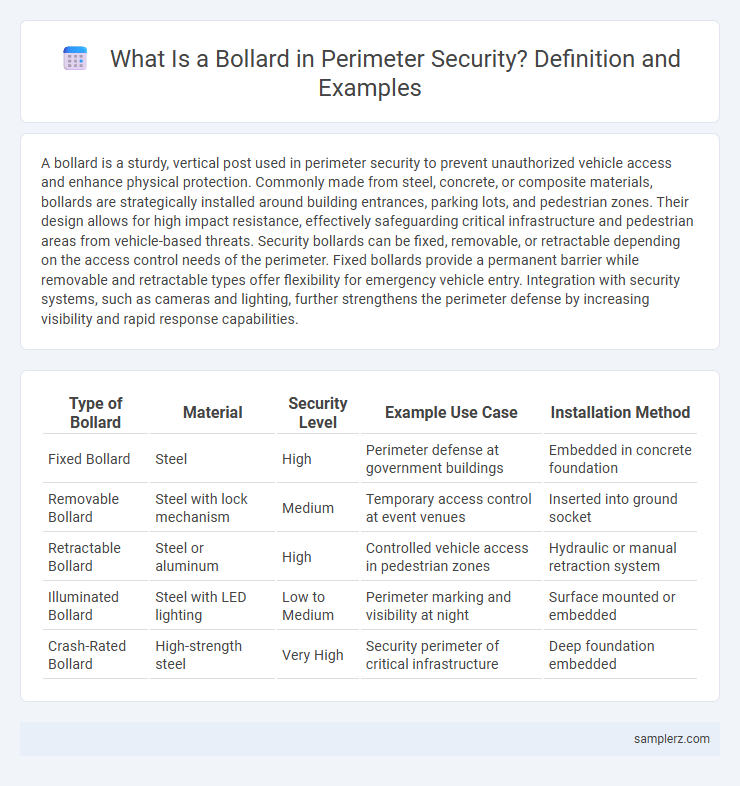A bollard is a sturdy, vertical post used in perimeter security to prevent unauthorized vehicle access and enhance physical protection. Commonly made from steel, concrete, or composite materials, bollards are strategically installed around building entrances, parking lots, and pedestrian zones. Their design allows for high impact resistance, effectively safeguarding critical infrastructure and pedestrian areas from vehicle-based threats. Security bollards can be fixed, removable, or retractable depending on the access control needs of the perimeter. Fixed bollards provide a permanent barrier while removable and retractable types offer flexibility for emergency vehicle entry. Integration with security systems, such as cameras and lighting, further strengthens the perimeter defense by increasing visibility and rapid response capabilities.
Table of Comparison
| Type of Bollard | Material | Security Level | Example Use Case | Installation Method |
|---|---|---|---|---|
| Fixed Bollard | Steel | High | Perimeter defense at government buildings | Embedded in concrete foundation |
| Removable Bollard | Steel with lock mechanism | Medium | Temporary access control at event venues | Inserted into ground socket |
| Retractable Bollard | Steel or aluminum | High | Controlled vehicle access in pedestrian zones | Hydraulic or manual retraction system |
| Illuminated Bollard | Steel with LED lighting | Low to Medium | Perimeter marking and visibility at night | Surface mounted or embedded |
| Crash-Rated Bollard | High-strength steel | Very High | Security perimeter of critical infrastructure | Deep foundation embedded |
Understanding Bollards: Key Elements in Perimeter Security
Bollards serve as essential physical barriers designed to prevent unauthorized vehicle access, enhancing perimeter security by controlling traffic flow and protecting sensitive areas. Constructed from sturdy materials such as steel or reinforced concrete, bollards can be fixed or retractable, allowing flexibility based on security needs. Their strategic placement around perimeters mitigates threats like ram-raiding and vehicle-borne attacks, making them a critical component in comprehensive security systems.
Types of Bollards Used for Security Perimeters
Fixed steel bollards provide robust physical barriers against vehicle intrusion, commonly installed in front of buildings or sensitive infrastructure for high-impact resistance. Removable bollards offer flexibility in access control, allowing temporary passage while maintaining perimeter security when locked in place. Automated bollards combine security with convenience, equipped with electronic controls for rapid deployment and retraction in response to authorized access requests.
Fixed Bollards: Reliable Protection for Critical Areas
Fixed bollards provide robust perimeter security by preventing unauthorized vehicle access to sensitive zones such as government buildings, data centers, and airports. Constructed from high-strength steel or reinforced concrete, these bollards are engineered to withstand high-impact collisions, thereby protecting critical infrastructure from potential ramming attacks. Their permanent installation ensures continuous defense without compromising pedestrian accessibility or operational flow in restricted areas.
Removable Bollards: Flexible Perimeter Solutions
Removable bollards enhance perimeter security by offering flexible access control without compromising protection, ideal for dynamic environments such as event venues and emergency access points. These bollards are constructed from high-strength steel or aluminum, enabling rapid deployment or removal to adapt to changing security needs. Integrating with automated control systems, removable bollards provide efficient management of vehicle flow while maintaining robust perimeter defense against unauthorized entry.
Retractable Bollards: Enhancing Security and Accessibility
Retractable bollards provide a flexible security solution by allowing controlled access to sensitive perimeters while maintaining pedestrian and vehicle flow. These bollards are designed to be raised or lowered quickly, offering robust protection against unauthorized vehicles without compromising accessibility for emergency services or authorized personnel. Their integration with access control systems enhances perimeter security by dynamically adapting to changing security needs.
Crash-Rated Bollards: High-Impact Security Applications
Crash-rated bollards provide critical high-impact security by withstanding vehicle collisions up to specific crash test ratings, such as K12 or K16, according to ASTM standards. These robust steel or concrete barriers are strategically installed around sensitive perimeters like government buildings, airports, and embassies to prevent unauthorized vehicular access and mitigate potential ramming attacks. Their ability to absorb and disperse kinetic energy makes crash-rated bollards essential for protecting pedestrians and infrastructure in high-risk zones.
Decorative Bollards: Blending Security with Aesthetics
Decorative bollards provide effective perimeter security by controlling vehicle access while enhancing the visual appeal of public spaces. Often constructed from durable materials like steel or cast iron, these bollards are designed with artistic elements that complement architectural styles without compromising safety. Integrating decorative bollards helps create secure environments in urban plazas, parks, and commercial properties, combining functional protection with aesthetic value.
Vehicle Access Control: Bollard Installation Scenarios
Vehicle access control employs bollards strategically installed at perimeter entry points to prevent unauthorized vehicle intrusion while allowing pedestrian movement. Common installation scenarios include high-security zones such as government buildings, commercial complexes, and airports, where bollards are used alongside barriers and gates to create layered defense systems. Removable or retractable bollards offer flexibility for emergency vehicle access without compromising overall perimeter security.
Bollards in Urban Security: Real-World Perimeter Examples
Bollards in urban security serve as vital perimeter barriers, effectively controlling vehicle access and enhancing pedestrian safety in busy city environments. Prominent examples include the concrete and steel bollards installed around Times Square in New York City, designed to prevent vehicle-based attacks while maintaining urban aesthetics. These bollards combine robust materials with strategic placement to secure sensitive areas such as government buildings, transit hubs, and public plazas.
Best Practices for Bollard Placement in Perimeter Security
Strategic bollard placement enhances perimeter security by deterring unauthorized vehicle access while maintaining clear sightlines and pedestrian pathways. Best practices include spacing bollards uniformly at 4 to 6 feet intervals to prevent vehicle penetration and positioning them at entry points, high-risk zones, and vulnerable building facades. Utilizing steel or reinforced concrete bollards embedded at least 3 feet deep ensures maximum impact resistance against ramming attacks.

example of bollard in perimeter Infographic
 samplerz.com
samplerz.com